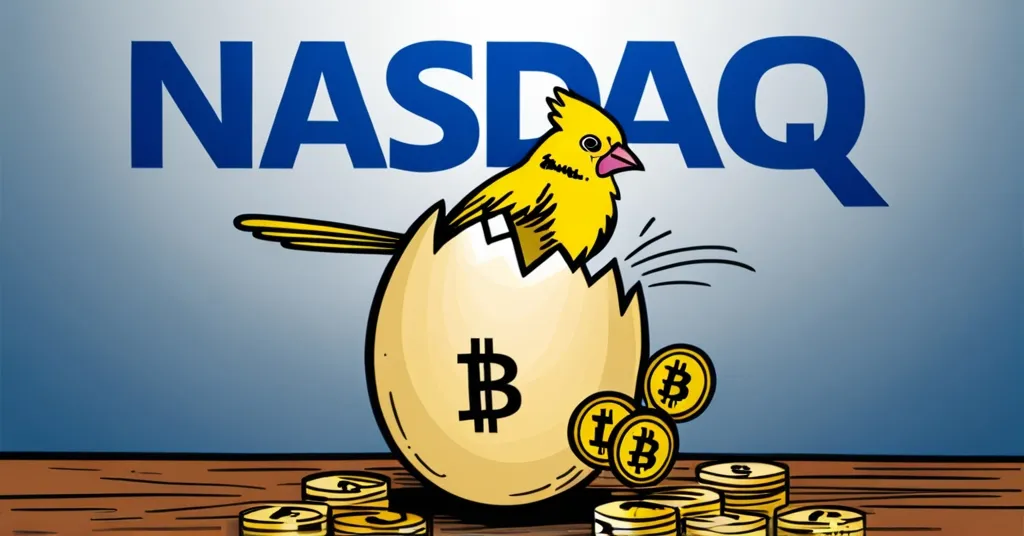Nasdaq Files for Canary Litecoin ETF: A Step Towards Crypto Mainstream

Nasdaq’s Bold Move: Filing for Canary Litecoin ETF Sparks Crypto Market Buzz
Nasdaq’s recent filing of a 19b-4 form for a Canary Litecoin ETF has ignited excitement in the crypto world, marking a significant step towards integrating Litecoin into traditional investment portfolios. This move by the asset management firm Canary aims to offer investors a straightforward way to gain exposure to Litecoin, known for its faster transaction times compared to Bitcoin.
- Nasdaq submits 19b-4 form for Canary Litecoin ETF
- Canary aims to offer investors direct Litecoin exposure
- Filing marks a step toward potential ETF approval
- Regulatory scrutiny and market volatility pose challenges
The Filing Process
Canary’s filing of the 19b-4 form with the Securities and Exchange Commission (SEC) initiates a crucial regulatory journey. This form seeks approval for the ETF to trade on Nasdaq, but it’s just the beginning. The SEC will meticulously review the application, balancing potential benefits against concerns over market manipulation (attempts to artificially influence asset prices) and investor protection (safeguarding investors from fraud and risk). As a spokesperson for Canary noted,
“The filing of the 19b-4 form is a significant milestone, but it’s just the beginning of a long regulatory journey.”
Institutional adoption refers to the acceptance and use of cryptocurrencies by large financial institutions, which can lend credibility and stability to digital assets. A digital asset, in this context, is a cryptocurrency like Litecoin that exists and is traded electronically. Litecoin, created by Charlie Lee in 2011, is often seen as the silver to Bitcoin’s gold, offering faster transaction times and a different mining algorithm. This proposed ETF aims to track Litecoin’s performance, providing a new avenue for both retail and institutional investors.
Potential Impacts
The potential approval of this ETF could act as a catalyst for increased institutional adoption of Litecoin. A market analyst remarked,
“This ETF could open the floodgates for more institutional money to enter the cryptocurrency space.”
This influx could boost Litecoin’s legitimacy and pave the way for similar products focused on other cryptocurrencies. Additionally, the ETF could lead to increased liquidity and price stability for Litecoin, attracting more investors. While this ETF could be a game-changer, let’s not forget the SEC’s track record of playing hard to get with crypto approvals.
Challenges Ahead
However, the path to approval is fraught with challenges. The SEC has historically been cautious about approving crypto-related ETFs, and the inherent volatility of the cryptocurrency market adds another layer of risk. While the optimism surrounding this development is palpable, it’s crucial to approach it with a balanced perspective, acknowledging both the potential and the pitfalls. The SEC isn’t exactly rolling out the red carpet for crypto ETFs; they’re more like scrutinizing every crumb on the floor.
Regulatory scrutiny remains a significant hurdle, as the SEC weighs the risks of market manipulation and the speculative nature of cryptocurrency investments. The regulatory approval process includes several steps after the 19b-4 form, such as public comment periods and further reviews, which can take months or even years.
The Broader Context
As we navigate this exciting yet uncertain terrain, the filing of the Canary Litecoin ETF represents a pivotal moment in the ongoing integration of cryptocurrencies into traditional financial systems. It’s a testament to the relentless pursuit of innovation in the crypto space, driven by a desire to disrupt the status quo and promote decentralization and freedom.
Yet, we must remain vigilant, recognizing that the journey ahead will be shaped by regulatory decisions and market dynamics. As we champion the potential of Litecoin and other cryptocurrencies to revolutionize finance, we must also confront the challenges head-on, ensuring that the path to adoption is both responsible and sustainable. Litecoin might be the silver to Bitcoin’s gold, but it’s racing to catch up in the ETF marathon.
Key Takeaways and Questions
- What is the significance of Nasdaq submitting a 19b-4 form for a Canary Litecoin ETF?
It signifies a step towards potentially offering investors a regulated way to gain exposure to Litecoin, which could increase institutional adoption and mainstream acceptance of cryptocurrencies.
- What are the potential impacts of a Litecoin ETF on the market?
It could lead to increased liquidity and price stability for Litecoin, attract more institutional investors, and pave the way for similar ETFs for other cryptocurrencies.
- What are the main concerns associated with the proposed ETF?
Regulatory hurdles and the speculative nature of cryptocurrency investments remain significant concerns, as the SEC has historically been cautious about approving crypto-related ETFs.
- How might the approval of a Litecoin ETF influence the broader cryptocurrency market?
Approval could signal to the market that cryptocurrencies are becoming more integrated into traditional finance, potentially boosting the legitimacy and adoption of other digital assets.



